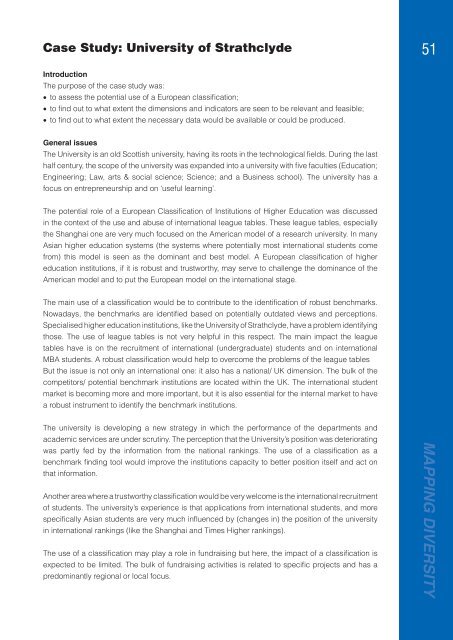Mapping Diversity: Developing a European Classification of ... - U-Map
Mapping Diversity: Developing a European Classification of ... - U-Map
Mapping Diversity: Developing a European Classification of ... - U-Map
Create successful ePaper yourself
Turn your PDF publications into a flip-book with our unique Google optimized e-Paper software.
Case Study: University <strong>of</strong> Strathclyde<br />
51<br />
Introduction<br />
The purpose <strong>of</strong> the case study was:<br />
• to assess the potential use <strong>of</strong> a <strong>European</strong> classifi cation;<br />
• to fi nd out to what extent the dimensions and indicators are seen to be relevant and feasible;<br />
• to fi nd out to what extent the necessary data would be available or could be produced.<br />
General issues<br />
The University is an old Scottish university, having its roots in the technological fi elds. During the last<br />
half century, the scope <strong>of</strong> the university was expanded into a university with fi ve faculties (Education;<br />
Engineering; Law, arts & social science; Science; and a Business school). The university has a<br />
focus on entrepreneurship and on ‘useful learning’.<br />
The potential role <strong>of</strong> a <strong>European</strong> Classifi cation <strong>of</strong> Institutions <strong>of</strong> Higher Education was discussed<br />
in the context <strong>of</strong> the use and abuse <strong>of</strong> international league tables. These league tables, especially<br />
the Shanghai one are very much focused on the American model <strong>of</strong> a research university. In many<br />
Asian higher education systems (the systems where potentially most international students come<br />
from) this model is seen as the dominant and best model. A <strong>European</strong> classifi cation <strong>of</strong> higher<br />
education institutions, if it is robust and trustworthy, may serve to challenge the dominance <strong>of</strong> the<br />
American model and to put the <strong>European</strong> model on the international stage.<br />
The main use <strong>of</strong> a classifi cation would be to contribute to the identifi cation <strong>of</strong> robust benchmarks.<br />
Nowadays, the benchmarks are identifi ed based on potentially outdated views and perceptions.<br />
Specialised higher education institutions, like the University <strong>of</strong> Strathclyde, have a problem identifying<br />
those. The use <strong>of</strong> league tables is not very helpful in this respect. The main impact the league<br />
tables have is on the recruitment <strong>of</strong> international (undergraduate) students and on international<br />
MBA students. A robust classifi cation would help to overcome the problems <strong>of</strong> the league tables<br />
But the issue is not only an international one: it also has a national/ UK dimension. The bulk <strong>of</strong> the<br />
competitors/ potential benchmark institutions are located within the UK. The international student<br />
market is becoming more and more important, but it is also essential for the internal market to have<br />
a robust instrument to identify the benchmark institutions.<br />
The university is developing a new strategy in which the performance <strong>of</strong> the departments and<br />
academic services are under scrutiny. The perception that the University’s position was deteriorating<br />
was partly fed by the information from the national rankings. The use <strong>of</strong> a classifi cation as a<br />
benchmark fi nding tool would improve the institutions capacity to better position itself and act on<br />
that information.<br />
Another area where a trustworthy classifi cation would be very welcome is the international recruitment<br />
<strong>of</strong> students. The university’s experience is that applications from international students, and more<br />
specifi cally Asian students are very much infl uenced by (changes in) the position <strong>of</strong> the university<br />
in international rankings (like the Shanghai and Times Higher rankings).<br />
The use <strong>of</strong> a classifi cation may play a role in fundraising but here, the impact <strong>of</strong> a classifi cation is<br />
expected to be limited. The bulk <strong>of</strong> fundraising activities is related to specifi c projects and has a<br />
predominantly regional or local focus.<br />
MAPPING DIVERSITY

















